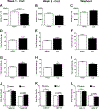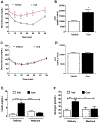One week of continuous corticosterone exposure impairs hepatic metabolic flexibility, promotes islet β-cell proliferation, and reduces physical activity in male C57BL/6 J mice
- PMID: 31536768
- PMCID: PMC6939671
- DOI: 10.1016/j.jsbmb.2019.105468
One week of continuous corticosterone exposure impairs hepatic metabolic flexibility, promotes islet β-cell proliferation, and reduces physical activity in male C57BL/6 J mice
Abstract
Clinical glucocorticoid use, and diseases that produce elevated circulating glucocorticoids, promote drastic changes in body composition and reduction in whole body insulin sensitivity. Because steroid-induced diabetes is the most common form of drug-induced hyperglycemia, we investigated mechanisms underlying the recognized phenotypes associated with glucocorticoid excess. Male C57BL/6 J mice were exposed to either 100ug/mL corticosterone (cort) or vehicle in their drinking water. Body composition measurements revealed an increase in fat mass with drastically reduced lean mass during the first week (i.e., seven days) of cort exposure. Relative to the vehicle control group, mice receiving cort had a significant reduction in insulin sensitivity (measured by insulin tolerance test) five days after drug intervention. The increase in insulin resistance significantly correlated with an increase in the number of Ki-67 positive β-cells. Moreover, the ability to switch between fuel sources in liver tissue homogenate substrate oxidation assays revealed reduced metabolic flexibility. Furthermore, metabolomics analyses revealed a decrease in liver glycolytic metabolites, suggesting reduced glucose utilization, a finding consistent with onset of systemic insulin resistance. Physical activity was reduced, while respiratory quotient was increased, in mice receiving corticosterone. The majority of metabolic changes were reversed upon cessation of the drug regimen. Collectively, we conclude that changes in body composition and tissue level substrate metabolism are key components influencing the reductions in whole body insulin sensitivity observed during glucocorticoid administration.
Keywords: Body composition; Glucocorticoid; Insulin resistance; Metabolic flexibility; Metabolomics.
Copyright © 2019 Elsevier Ltd. All rights reserved.
Figures







Similar articles
-
Oral Corticosterone Administration Reduces Insulitis but Promotes Insulin Resistance and Hyperglycemia in Male Nonobese Diabetic Mice.Am J Pathol. 2017 Mar;187(3):614-626. doi: 10.1016/j.ajpath.2016.11.009. Epub 2017 Jan 4. Am J Pathol. 2017. PMID: 28061324 Free PMC article.
-
β-Cell adaptation in a mouse model of glucocorticoid-induced metabolic syndrome.J Endocrinol. 2013 Oct 28;219(3):231-41. doi: 10.1530/JOE-13-0189. Print 2013 Dec. J Endocrinol. 2013. PMID: 24048967
-
Pharmacological inhibition of lipolysis prevents adverse metabolic outcomes during glucocorticoid administration.Mol Metab. 2023 Aug;74:101751. doi: 10.1016/j.molmet.2023.101751. Epub 2023 Jun 7. Mol Metab. 2023. PMID: 37295745 Free PMC article.
-
A rodent model of rapid-onset diabetes induced by glucocorticoids and high-fat feeding.Dis Model Mech. 2012 Sep;5(5):671-80. doi: 10.1242/dmm.008912. Epub 2011 Dec 19. Dis Model Mech. 2012. PMID: 22184636 Free PMC article.
-
Cigarette smoke exposure impairs β-cell function through activation of oxidative stress and ceramide accumulation.Mol Metab. 2020 Jul;37:100975. doi: 10.1016/j.molmet.2020.100975. Epub 2020 Mar 13. Mol Metab. 2020. PMID: 32283079 Free PMC article.
Cited by
-
Potent Anti-Inflammatory, Arylpyrazole-Based Glucocorticoid Receptor Agonists That Do Not Impair Insulin Secretion.ACS Med Chem Lett. 2021 Sep 15;12(10):1568-1577. doi: 10.1021/acsmedchemlett.1c00379. eCollection 2021 Oct 14. ACS Med Chem Lett. 2021. PMID: 34676039 Free PMC article.
-
High-Protein Diet Prevents Glucocorticoid-Induced Fat Mass Accumulation and Hyperglycemia.Int J Mol Sci. 2025 Apr 29;26(9):4212. doi: 10.3390/ijms26094212. Int J Mol Sci. 2025. PMID: 40362449 Free PMC article.
-
Pioglitazone Reverses Markers of Islet Beta-Cell De-Differentiation in db/db Mice While Modulating Expression of Genes Controlling Inflammation and Browning in White Adipose Tissue from Insulin-Resistant Mice and Humans.Biomedicines. 2021 Sep 10;9(9):1189. doi: 10.3390/biomedicines9091189. Biomedicines. 2021. PMID: 34572374 Free PMC article.
-
The Ubiquitin Ligase SIAH2 Negatively Regulates Glucocorticoid Receptor Activity and Abundance.Biomedicines. 2020 Dec 30;9(1):22. doi: 10.3390/biomedicines9010022. Biomedicines. 2020. PMID: 33396678 Free PMC article.
-
Adipocyte STAT5 (signal transducer and activator of transcription 5) is not required for glucocorticoid-induced metabolic dysfunction.Am J Physiol Endocrinol Metab. 2023 Nov 1;325(5):E438-E447. doi: 10.1152/ajpendo.00116.2023. Epub 2023 Sep 13. Am J Physiol Endocrinol Metab. 2023. PMID: 37702737 Free PMC article.
References
-
- Granner DK, Wang JC, Yamamoto KR, Regulatory Actions of Glucocorticoid Hormones: From Organisms to Mechanisms, Adv Exp Med Biol, 872 (2015) 3–31. - PubMed
-
- Ratman D, Vanden Berghe W, Dejager L, Libert C, Tavernier J, Beck IM, De Bosscher K, How glucocorticoid receptors modulate the activity of other transcription factors: a scope beyond tethering, Mol Cell Endocrinol, 380 (2013) 41–54. - PubMed
-
- Rhen T, Cidlowski JA, Antiinflammatory action of glucocorticoids--new mechanisms for old drugs, N Engl J Med, 353 (2005) 1711–1723. - PubMed
-
- Lin KT, Wang LH, New dimension of glucocorticoids in cancer treatment, Steroids, 111 (2016) 84–88. - PubMed
Publication types
MeSH terms
Substances
Grants and funding
LinkOut - more resources
Full Text Sources
Medical

